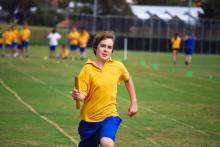DENVER – The annual number of emergency department visits for treatment of running-related injuries in 6- to 18-year-olds climbed by more than one-third from 1994 to 2007, according to a large national study.
More than one-half of these injuries occurred while the affected children and adolescents were at school, Lara Beth McKenzie, Ph.D., reported at the annual meeting of the American Public Health Association.
A particularly interesting finding in this study, believed to be the first-ever analysis of pediatric running-related injuries treated in U.S. emergency departments, was that one in three such injuries involved a running-related fall. This intriguing observation warrants further study with the aim of developing scientific evidence-based guidelines for pediatric running to replace the expert opinion–based recommendations now in place, according to Dr. McKenzie of the Center for Injury Research and Policy at Nationwide Children’s Hospital in Columbus, Ohio.
She presented an analysis of data from the National Electronic Injury Surveillance System for 1994-2007. The surveillance system, operated by the U.S. Consumer Products Safety Commission, collects data from a representative national sample comprising 100 U.S. hospitals.
Extrapolating from the weighted sample, an estimated 225,344 school-age youths were treated for running-related injuries in emergency departments during 1994-2007. The annual rate climbed from 24.2 injuries per 100,000 population in 1994 to 29.3/100,000 in 2007, a 21% increase in incidence. These figures undoubtedly underestimate the true number of running-related injuries, because they don’t include running mishaps treated in the offices of pediatricians, family physicians, or in urgent care clinics, Dr. McKenzie noted. On the other hand, it’s likely that patients with the most severe injuries found their way to the emergency department.
Many running injuries involved the lower extremities. Ankle injuries accounted for 31% of all running injuries, knee injuries 15%, and foot injuries 9%.
Fifty-two percent of all running-related injuries consisted of sprains and strains. Fractures occurred in 16% of patients and were most common when the injury involved an upper extremity.
Focusing on the issue of running-related falls, Dr. McKenzie observed that essentially no literature exists on this important topic. Forty-four percent of children aged 6-11 years had a fall-related injury; indeed, children in this age group were 81% more likely to sustain a fall-related injury than were 12- to 18-year-olds, a group in which overuse injuries were more common than were acute running-related trauma.
Falls tended to result in more serious injuries; they were significantly more likely to involve fractures, lacerations, and/or soft tissue injuries and they led to hospitalization more often than did running injuries not involving a fall.
Three-quarters of all running-related injuries incurred at school were in children aged 6-14 years. Older teens were most likely to get hurt while running in the street or at a sports facility or park.
Dr. McKenzie stressed that she’s by no means anti-running for children. It’s a form of physical activity that effectively fights the pediatric obesity epidemic, and it’s a practical tool for parents and gym teachers because it requires minimal equipment and is available to kids of all skill levels. But scientifically informed guidelines specifically for young runners are needed.
Dr. McKenzie declared no potential conflicts of interest.

